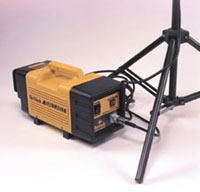The Britek Dayphoto Lighting System
In the quest for the perfect
digital image I have learned an awful lot. Besides learning more than
I ever hoped to know about ROM, RAM, Cache, and SCSI, I have learned
way too much about continuous lighting. Continuous lighting, as the
name suggests, is good old-fashioned light from light bulbs or the sun.
Since light from the sun is hardly controllable, light bulbs of all
sorts are the next best solution. |
|||
Since I use a scanning camera
back that actually moves a thin wand of pixels across the film plane,
I need a steady even form of lighting. I blew my entire budget on the
camera, computer, software, and monitor, so I didn't have a lot
of dough left over for a fancy lighting scheme. My first idea was that
I would use the 250w lamps in my flash heads, since that seemed like a
lot of light to me. I had used the modeling lights on a few jobs with
some tungsten film and got a decent exposure of f/16 at 11/2 sec. Guess
what--a scanning camera steps the CCD across the image, and my camera
can shoot an 8500 pixel wide image. Even a reasonable 3500x3500 pixel
image would require 3500 separate 1.5 sec exposures, for an unbearable
hour and a half scan. Even with the lens wide open I was looking at some
slow scans. Wide open I was looking at 13 minute scans, so I quickly torpedoed
that idea. |
- Log in or register to post comments



































